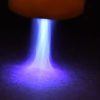In recent years, researchers have been trying to develop increasingly efficient and advanced solar technologies. One way of increasing the efficiency of solar cells is to reduce energy losses (i.e., voltage losses) caused by non-radiative recombination processes.
Researchers at the University of Arizona and Linköping University in Sweden have recently carried out a study aimed at better understanding non-radiative voltage losses in organic solar cells. Their paper, published in Nature Energy, describes the way in which energy losses occur both in fullerene-based and nonfullerene-based solar cells.
“Note that photon absorption leads to the formation of an excited electronic state in the electron-acceptor and/or electron-donor component of the active layer,” Jean-Luc Bredas, one of the researchers who carried out the study, told TechXplore. “This excited state evolves into a so-called charge-transfer (CT) electronic state at the interface between the acceptor and donor components. This CT state can then dissociate into free charge carriers or decay to the ground state.”
After CT states dissociate into free charge carriers, these carriers should ideally move to electrodes, where they are ultimately extracted. Along the way, however, some of these charge carriers can also recombine, through a process known as biomolecular recombination.
Biomolecular recombination processes also occur via CT states. Therefore, to optimize the efficiency of organic solar cells, one should minimize the non-radiative decay of the CT states. In their paper, the Arizona and Linköping teams and their colleagues provide a unified description of non-radiative voltage losses in organic solar cells.
“We were able to describe equally well the situation in both fullerene-based and nonfullerene-based solar cells,” Bredas explained. “This unified description was reached by combining theoretical efforts at Arizona and experimental efforts, mainly carried out at Linköping. On the theoretical side, we were able to consider all the relevant electronic states, that is: the ground state, the CT state, and the strongly absorbing state within the acceptor and/or donor.”
Previously proposed models of non-radiative decay do not consider the strongly absorbing state within acceptors and/or donors. Therefore, they failed to provide a complete picture of non-radiative voltage losses, which would be required to fully understand its impact, particularly on highly efficient nonfullerene-based solar cells. In contrast, the theoretical model by Bredas and his colleagues describes non-radiative energy losses both in fullerene-based and nonfullerene-based solar cells.
From an experimental standpoint, the team at Linköping University was able to characterize the CT states and solar-cell parameters for over 30 systems. These systems include both fullerene-based and nonfullerene-based active layers.
“The combination of these efforts offers an unprecedented, in-depth understanding of the reasons why highly efficient nonfullerene-based organic solar cells have small energy/voltage losses,” Bredas said.
In the course of their investigations, Bredas and his colleagues made several interesting observations. First, they found that the luminescence of pristine acceptor and donor components define the extent of voltage losses. Second, their experiments showed that voltage losses can be reduced without sacrificing or impacting charge generation efficiencies.
“The power the solar cell can generate is current times voltage,” Bredas said. “Reducing the voltage loss obviously increases the maximum voltage that can be generated. There were concerns in the community that the way the voltage loss can be reduced would also reduce charge generation and therefore the maximum current that can be generated. We show this is in fact not at all necessarily the case.”
In the future, this paper could inform the development of more efficient solar cells and solar technologies. More specifically, the study highlights the benefits of using donor and acceptor materials with a high luminescence efficiency, as well as complementary optical absorption bands that extend into the near-infrared region. These materials, in fact, could help to maximize the collection of photons when the solar cells are exposed to sunlight.
“In our next studies, we plan to explore the implications of our findings further,” Bredas said. “More specifically, we would like to obtain a better understanding of how the experimental processing of the active layer impacts the morphology of the layer, its electronic properties, and ultimately the overall device performance and stability. The Linköping and Arizona groups are also very keen to keep their collaboration going, as this is a perfect example of how what we are doing together can be much more than the mere sum of the parts.”
Benchmarks to better catch the sun
More information:
A unified description of non-radiative voltage losses in organic solar cells. Nature Energy(2021). DOI: 10.1038/s41560-021-00843-4.
2021 Science X Network
Citation:
Study provides a unified description of non-radiative voltage losses in organic solar cells (2021, July 5)
retrieved 6 July 2021
from https://techxplore.com/news/2021-07-description-non-radiative-voltage-losses-solar.html
This document is subject to copyright. Apart from any fair dealing for the purpose of private study or research, no
part may be reproduced without the written permission. The content is provided for information purposes only.



